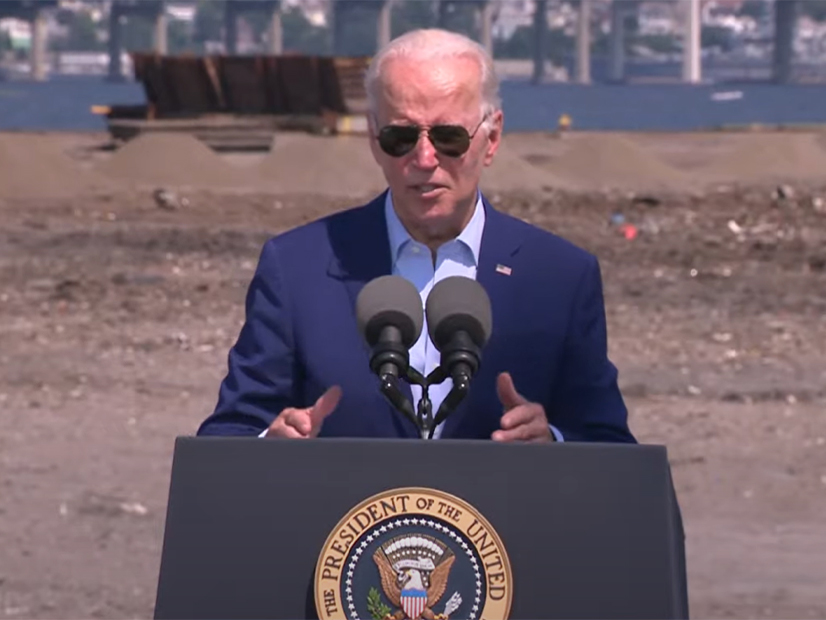
With a construction site at what was once a 1,500-MW coal plant as his backdrop, President Biden on Wednesday proclaimed climate change a “clear and present danger” to the U.S., to which he would respond “with urgency and resolve.”
In his speech at the former Brayton Point coal plant in Somerset, Mass., Biden did not declare an official national emergency, but he said, “When it comes to fighting climate change, I will not take ‘no’ for an answer.”
Congress has failed in its duty to act on climate, Biden said, “and in the coming weeks, I’m going to use the power I have as president to turn these words into formal, official government actions through the appropriate proclamations, executive orders and regulatory power that the president possesses.”
Among that will be $2.3 billion in federal funding “to help communities across the country build infrastructure that’s designed to withstand the full range of [climate] disasters,” the president announced.
According to a senior administration official earlier in the day, those funds will come from the Federal Emergency Management Agency’s Building Resilient Infrastructure and Communities Program. Another $385 million in funding from the Low Income Home Energy Assistance Program, traditionally used for energy-efficient upgrades for homes in low-income communities, is being made available for states to use to set up cooling centers and help low-income residents buy air-conditioning units, the official said.
But both the official and National Climate Advisor Gina McCarthy, in a morning appearance on CNN’s “New Day,” talked around questions about if and when the president might declare climate change a national emergency and what actions he might take.
Declaring climate change a national emergency is “just not the announcement today,” McCarthy said. “The announcement today is going to be about making the case that climate change is an emergency [and] outlining actions that we’re going to moving forward over the coming weeks.
“We are going to act,” she said. “But the president is going to outline that at his pace.”
Clearing the Way for OSW
That deliberate pacing could account for Biden burying possibly his administration’s most important action halfway through his speech.
The president announced the next step in opening the Gulf of Mexico to offshore wind projects, with the Bureau of Ocean Energy Management (BOEM) identifying two potential wind energy areas (WEAs) in the gulf and opening a 30-day comment period on the sites.
According to a press release from the Department of the Interior, one of the proposed sites, totaling 546,645 acres, is located 24 nautical miles off Galveston, Texas, while the other, with 188,023 acres, is located approximately 56 nautical miles off the coast of Lake Charles, La.
The sites were chosen using “the most current scientific data to analyze 30 million acres in the [gulf] to find the best spaces for wind energy development,” said BOEM Director Amanda Lefton. “We are invested in working in partnership with states and communities to find areas that avoid or minimize conflicts with other ocean uses and marine life in the Gulf of Mexico.”
“We’re going to make sure that the ocean is open for the clean energy of our future,” Biden said. Projects off the Atlantic Coast and the gulf could provide “a real opportunity to power millions of additional homes from wind,” he said. “Let’s clear the way for clean energy and connect these projects to the grid.”
Biden also highlighted progress on Vineyard Wind 1, the 804-MW offshore project now under construction off Martha’s Vineyard. Brayton Point is now being repurposed as an DC-to-AC converter station to interconnect Vineyard, and potentially other OSW projects, to the grid through underwater transmission. (See Ex-Coal Plant Site Chosen for Mass. OSW Hub.)
On a Tight Rope
Since Sen. Joe Manchin (D-W.Va.) last week shut down negotiations over a pared-down budget reconciliation package that included a number of clean energy tax credits and other incentives, exactly what Biden will do and when he will do it has been a topic of debate and speculation.
Biden’s speech echoed his initial reaction to Manchin’s decision, citing concerns about June’s record 9.1% consumer price index and inflation. (See Biden: ‘I Will not Back Down” on Climate Action.)
Declaring a national emergency would add to a list of more than 40 executive orders in effect under the 1976 National Emergencies Act (NEA), with some issued nearly 30 years ago by President Bill Clinton. But a group of nine senators said in a letter to Biden that it would “unlock powers to rebuild a better economy with significant concrete actions.”
Led by Sen. Jeff Merkley (D-Ore.), the group said, “You could redirect spending to build out renewable energy systems on military bases, implement large-scale clean transportation systems and finance energy projects to boost climate resiliency,” the group said
Joining the letter, sent Wednesday, were Sens. Ed Markey (D-Mass.), Cory Booker (D-N.J.), Bernie Sanders (I-Vt.), Elizabeth Warren (D-Mass.), Sen. Sheldon Whitehouse (D-R.I.), Brian Schatz (D-Hawaii), Martin Heinrich (D-N.M.) and Alex Padilla (D-Calif.).
Meanwhile, Sen. John Barrasso (R-Wyo.), ranking member of the Senate Energy and Natural Resources Committee, was quick to criticize Biden’s focus on climate as out of touch with American families who “need energy that is affordable and reliable. Instead of taking action to ease the pain at the pump, the president doubled down today on his extreme climate agenda. This will only push energy prices higher.”
But Sheila Hollis, acting executive director of the U.S. Energy Association, saw Biden’s speech as an exercise in balance and pragmatism.
“He’s trying to make a statement [that] is in the realm of reality, as opposed to super long-term visions of how things should be,” Hollis said in a phone interview. “He did about the best he could under circumstances because there’s so many competing interests, competing concerns, international concerns and just the complexities of our system of regulating and distributing and making energy available.
“Anybody that is not simply didactic has to walk a tightrope,” Hollis said. “He’s on a tight rope.”


